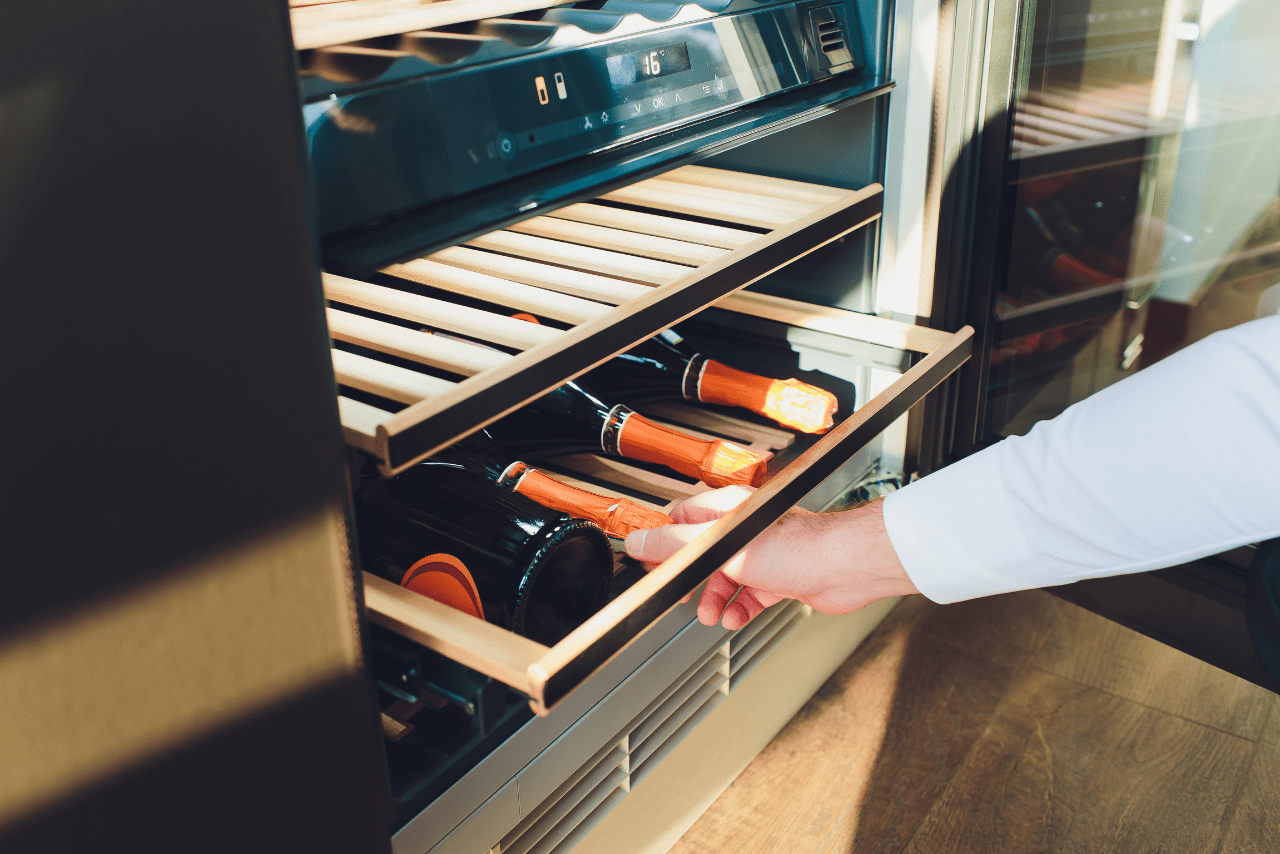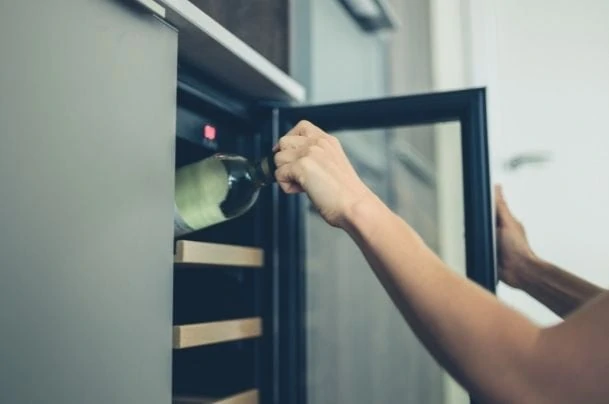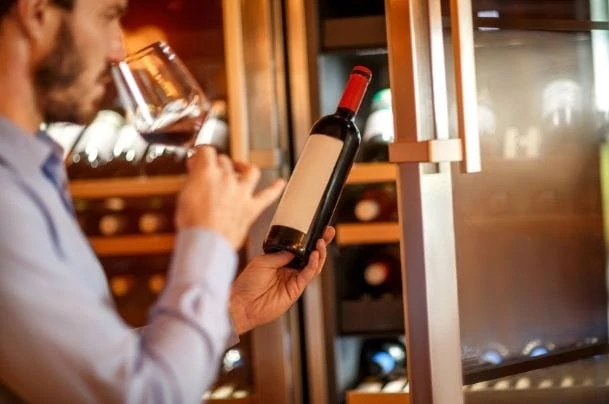Last Updated: April 13, 2024
When we hear the word "wine cooler," the first thing that comes to mind is that it's a compartment for your wine bottles to keep the wine chilled.
However…
A regular fridge does the same thing, right? Not only can it chill wine, but also other foods and drinks. So, what makes wine so unique that we need a specific container for it?
It turns out there's a massive difference between a fridge vs a wine cooler, and the storage system that you choose can change wine quality in the long run!
Wine Cooler vs Fridge
At first glance, it may seem convenient and logical to store wine in a regular refrigerator. However, there's a reason why the wine cooler was invented (wine fridge vs wine cooler, they’re the same terms).
Let's compare their features, shall we?
Temperature
The first thing you want to consider is keeping the ideal temperature range between 45F to 60F. Any colder than 25F and the wine will freeze, while any hotter than 68F will age prematurely.
However, it's also essential to maintain a fixed temperature. The wine bottle's cork expands and contracts when the temperature fluctuates, causing the wine to seep out or air to seep in.
A fixed temperature is impossible for kitchen fridges because it fluctuates whenever we open and close the fridge door. Now, imagine how many times a kitchen fridge opens in a big household!
Meanwhile, wine coolers enable you to maintain the ideal temperature and humidity for wine storage.
Bottle Capacity
When you compare the layout and shelving, wine refrigerators have racks and contours that fit the shape of wine bottles.
There are even wine coolers that have separate compartments so you can serve different wines at different temperatures (more on that later)!
Theoretically, there's a lot of storage capacity if you use your kitchen fridge exclusively for wine, but doesn't that defeat the purpose of a kitchen fridge?
Storage Conditions
However, as seen from the side doors of a regular fridge, drinks and other bottles are meant to be stored vertically to save space.
With all the other food inside a kitchen fridge, imagine if the wine cork suddenly shrinks. All the surrounding odors can seep into the wine - you don't want to have wine with a hint of fish!
Additionally, vibrations disrupt the sediments inside the wine, which affects the aging process. Think about all the vibrations in a regular fridge - when the compressor activates, when you use the water/ice dispenser, and more.
Although some wine cooler units operate using a compressor, they have an absorption system that minimizes vibrations. Some units even run with a thermoelectric device, which doesn't vibrate at all!
Wine Cooler Specifications
It's pretty clear that storing your wine in a regular fridge isn't the best idea. Now, how can you select the best wine cooler?
Compressor-Based vs Thermoelectric
A compressor wine cooler is much like a mini fridge. It uses a coolant gas through the vapor-compression refrigeration system to transfer internal heat out of the unit.
Meanwhile, a thermoelectric model removes heat using the Peltier effect. It sends an electric current between two different metals that are adjoined together.
Because of the two different materials, the thermoelectric device creates a heat flux, wherein the flow of heat causes one side to be hot and the other to be cold.
The cold side is installed inside the wine fridge, while the hot side is attached to a heat sink, allowing the heat to dissipate.
The main advantage of using compressor-based is its cheap operation. It's also best for large units (25+ bottles), and it has a higher temperature range to achieve the proper serving temperature for sparkling wine like champagne.
On the other hand, a thermoelectric wine cooler is cheap to purchase (not operate) and environmentally friendly. It also has fewer moving parts than a compressor-based model, so you don't have to worry about vibrations.
Built-In vs Freestanding
The question is, can you place a freestanding wine cooler in a counter/cabinet space? Let's look at the specific differences between the two.
A built-in model has a front vent located below the door, so the heat escapes from the front of the cooler. Meanwhile, a freestanding model's vents are at the sides/back.
If you place a freestanding wine refrigerator in a counter/cabinet space, there may not be enough space for airflow, which would affect its capability to maintain the proper internal temperature.
This would then cause the cooling system to overcompensate and eventually overheat.
If you want to place your freestanding wine fridge in a counter/cabinet space, ensure that the vents have enough space to maintain proper heat flow.
Single vs Dual Zone
The difference between these two is simple.
A single zone wine refrigerator only has one compartment and one temperature control, so all the wine bottles are kept at the same temperature.
Meanwhile, a dual-zone model has two compartments with their own temperature control, so different wines can be stored at different temperatures.
So, what's the purpose of a dual-zone unit?
Although all types of wine can be stored at the same temperature, their serving temperature differs. For example, white wine should be served between 45-52F, while red wine should be between 53-57F.
If you're only using the wine cooler for storage, then a single zone would do just fine. However, if you have quite the wine collection you're willing to serve, we recommend a dual-zone.
Frequently Asked Questions
1. How do I store my wine?
To summarize, here are the following steps to proper wine storage:
- Keep it in the ideal temperature and humidity
- Avoid vibrations
- Position the bottle horizontally
Depending on where you position your wine cooler (or if you're planning to have a wine cellar), lighting must also be strictly monitored. Light bulbs and sunlight give off heat, which may disrupt the temperature.
2. Are there other forms of wine storage?
Aside from the fridge vs wine cooler comparison, you can also consider the following:
Wine Cooler vs Beverage Cooler
Also called a beverage center, a beverage cooler stores different drinks such as soda, beer, and wine.
However, keep in mind that wine is typically stored at a higher temperature than other beverages.
Unless you have a dual-zone beverage center, storing wine with other beverages may cause your wine to be too cold or your other drinks to be too warm, depending on how you set the temperature.
Wine Cooler vs Wine Cellar
If you're a wine enthusiast, the best place to store wine is in wine cellars. It's basically a large area for bottles/barrels of wine - think of a wine cooler, but turn it into an entire room.
Building a wine cellar takes a lot of budget and commitment - apart from the construction of the room itself, you also need to consider climate control to maintain the ideal environment for storing wine.
Here's an informative video about wine storage and wine refrigeration:
3. How do I clean my wine cooler?
Here are the steps to clean your wine cooler:
- Unplug the cooler
- Remove all contents, including detachable parts
- Clean the internal and external surfaces of the cooler, as well as wire shelves (if any) using a mild cleaner
- Clean wooden shelves (if any) using a wood cleaner
- Rinse parts with lukewarm water
- Dry using a soft cloth
Caution:
- Use a soft cloth/sponge; avoid abrasive and harsh cleaning materials
- Avoid wetting electronic parts
The Final Verdict
When you look at a wine cooler vs a mini fridge, do you still think they’re the same thing? Even when compared to a regular kitchen fridge, a wine cooler still does its job better. It provides the ideal storage conditions for your wine, so having one is essential for every wine enthusiast. Once you invest in a wine cooler, you'll be thanking yourself in the long run for how much your wine improves as it ages!
With that being said, why don't you grab yourself a nice glass of wine while you read the latest issue of Wine Spectator?


